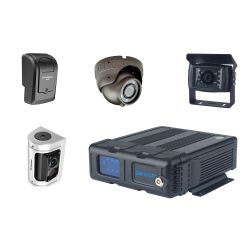Predictive Maintenance VS Preventive Maintenance: Which Is Beneficial?
April 14, 2021
How Predictive Maintenance Can Be More Cost Effective Than Preventive Maintenance
Fleets are entering a time where efficiency is rewarded heavily and the faster processes take place, the more the fleets benefit. But in the race of making processes efficient and increasing profits, fleets tend to forget about the long-term game.
Vehicles being used to their fullest potential gives the best results, but without taking proper care of them and without ensuring proper predictive maintenance taking place, vehicles won’t last as long as they can. Although fleets are aware of this, they prefer to ignore predictive maintenance procedures because it requires a great amount of additional effort. But technology has come far and automation has made a huge impact on various industries, including the logistics industry.
More specifically, telematics has been on the rise for the last couple of years and has proven to increase fleets in various ways, especially when it comes to proper maintenance and care of the fleet.
What is Predictive Maintenance?
Predictive maintenance is a procedure using data analysis tools and techniques to find any issues in the operations and possible defects in equipment so they can be fixed before they cause bigger problems.
In simple terms, predictive maintenance (PM) is a procedure to reduce maintenance frequency to prevent unplanned maintenance operations and costs, without the costs associated with doing too much preventive maintenance.
How Does Predictive Maintenance Work?
The three main areas of an organization that factor into predictive maintenance are the real time monitoring of asset condition and performance, the analysis of work order data and the benchmarking MRO (maintenance, repair, and operations) inventory usage.
Tools like IoT, AI and integrated systems allow for different assets and systems to connect, work together, share, analyze and action data. Some examples of using PM and PM sensors are vibration analysis, oil analysis, thermal imaging and equipment observation.
The Difference Between Predictive & Preventive Maintenance
Preventive maintenance occurs on the same schedule every cycle, whether or not it’s actually required. Preventive maintenance is designed to keep the parts of a vehicle in good repair but doesn’t take the state of the part or process into consideration.
Whereas predictive maintenance occurs when needed, as it depends on real time collection and analysis of machine operation data to identify issues before they become a real problem. With predictive maintenance, repairs happen during machine operation and address an actual problem. For example, if a shutdown is required, it will be shorter and more targeted.
Benefits of Predictive Maintenance
As mentioned earlier, predictive maintenance is only performed on machines just before failure is likely to occur. This results in several cost savings that include minimizing maintenance time on equipment, production hours that would otherwise be lost to unrequired maintenance and the cost of spare parts and supplies that weren’t necessary.
Predictive maintenance programs have been shown to lead to a tenfold increase in ROI, a 25%-30% reduction in maintenance costs, a 70%-75% decrease of breakdowns and a 35-45% reduction in downtime.
Predictive Maintenance Pushed Towards Automation
- Integrating Data Capture Devices In Equipment
The primary step to automating predictive maintenance is to capture relevant data from the equipment. Usually, general manufacturing equipment is equipped with sensors and actuators monitoring performance and the health of components. If that’s not the case, data capture is typically achieved after the integration of smart devices into legacy equipment.
Artificial Intelligence can be used to track the temperature, vibration and other aspects of a piece of equipment. With this data in place, as well as downtime or failure rate data, the process of automating predictive maintenance activities can be achieved. The fleet must also set up industrial cloud solutions, analytical applications and a functional ticketing or alert system to automate the predictive maintenance process.
- Algorithms To Monitor Patterns In Real Time
For fleets that are just starting out, typically, data won’t be available that provides context into an equipment’s health. In this case, fleets will need to invest in services or have to build applications powered by algorithms that enable condition based monitoring.
- A Fundamental Mindset Change To Maintenance
Successfully integrating automated predictive maintenance in a shop floor still depends on management and employee knowledge of predictive analysis. This is why a management and employee policy on automating predictive maintenance is important.
- Carving Maintenance Activity To Best Suit A Fleet’s Processes
Whatever approach is best for a certain asset or piece of equipment, a CMMS with a high level of automation will allow fleets to mold their maintenance activities based on their processes and best practices. For example, a fleet can generate a corrective work order based on certain reading thresholds of an asset, follow a workflow chain that mimics an organization’s sign off authority and automatically notifies other relevant personnel when work is completed.
ZenduMA – A Fleet’s Solution To Predictive Maintenance
When discussing automating predictive maintenance processes, fleets should have a look at Zendu Maintenance. One of ZenduMA’s users mentioned, “We would use paper forms that were solely managed by the technicians and sometimes would fall through the cracks as a result of their lack of organization. The biggest improvement has been the ease-of-use in regards to creating work orders on the go with the mobile app.”.
ZenduMA is a web-based maintenance management system allowing you to run fleet maintenance operations more effectively and uses the concept of predictive maintenance and combines it with the concept of preventive maintenance. This combination of both methods enables fleet vehicles to have the longest lifespan possible, all while saving on costs that would have occurred from just using the method of preventive maintenance.
The ZenduMA solution prevents the number of downtimes by proactively testing and analyzing diagnostics reports. This is a result of faster repair times since it allocates resources like tools and fuel better with reports and maintenance alerts. For a fleet who is looking out for a solution to fully take care of the predictive maintenance processes, ZenduMA is a great solution to be taken into consideration.
With this in mind, fleets should start looking into solutions to help them out with improving their maintenance processes. Using telematics and data to shift away from reactive maintenance can cut down significantly on emergency repairs, which helps fleets continue to move their goods and improve their business. To learn more about how your fleet can benefit from proper maintenance, contact us today.










